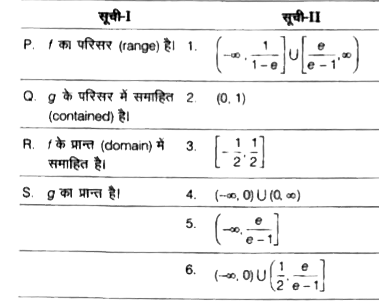माना एक फलन f:(0,∞)→(0,∞)f(x)=∣∣∣1−1x∣∣∣ द्वारा परिभाषित है, तो f
केवल एकैकी है
एकैकी और आच्छदि दोनों
न एकैकी है न आच्छदि है
आच्छदि है पर एकैकी नहीं है
The correct Answer is:C
Step by step video, text & image solution for माना एक फलन f: (0, oo) to (0, oo) f(x)=|1-(1)/(x)| द्वारा परिभाषित है, तो f by Maths experts to help you in doubts & scoring excellent marks in Class 12 exams.
Updated on:21/07/2023Topper's Solved these Questions
- JEE MAIN 2019BOOK - JEE Main & Advanced (Hindi Medium)CHAPTER - JEE MAIN 2019EXERCISE - 12 January Shift-I
30 Videos
- JEE MAIN 2019BOOK - JEE Main & Advanced (Hindi Medium)CHAPTER - JEE MAIN 2019EXERCISE - 12 January Shift-II
30 Videos
- JEE MAIN 2019BOOK - JEE Main & Advanced (Hindi Medium)CHAPTER - JEE MAIN 2019EXERCISE - 11 January Shift - I
30 Videos
- JEE ADVANCED सोल्वड पेपर्स 2018 BOOK - JEE Main & Advanced (Hindi Medium)CHAPTER - JEE ADVANCED सोल्वड पेपर्स 2018 EXERCISE - पेपर 2 (खण्ड 3)
4 Videos
- JEE MAIN QUESTION PAPER 2013BOOK - JEE Main & Advanced (Hindi Medium)CHAPTER - JEE MAIN QUESTION PAPER 2013EXERCISE - PART-C - गणित (MATHEMATICS)
30 Videos
Similar Questions
यदि z−αz+α(α∈R) एक शुद्ध रूप से काल्पनिक संख्या है तथा |z|=2 है तो α का एक मान है
View Solutionयदि λ के उन सभी वास्तविक मानो, जिनके लिए बिन्दुओ (−λ2,1,1),(1,−λ2,1) तथा (1,1−λ2) से होकर जाने वाला एक समतल, बिन्दु (−1,−1,1) से भी होकर जाता है, का समुच्चय S है, तो S बराबर है
View Solutionसमुच्चय {1,2,….,11} से दो पूर्णांक यादृच्छिक लिए गे हैं। दिया है कि ली गई संख्याओं का योग सम है , दोनों संख्याओं के सम होने की सप्रतिबन्ध (conditional) प्रायिकता है
View Solutionमाना की E1={x∈R:x≠1औरxx−1>0} और E2={x∈E1sin−1(loge(xx−1)} एक वास्तविक संख्या (real number) है|
(यहाँ प्रतिलोम त्रिकोणमितीय फलां (inverse trignometric function) sin−1x,[−π2,π2] में मान धारण करता है|
माना की फलन: f:E1→R,f(x)=loge(xx−1) के द्वारा परिभाषित है
और फलन f:E2→R,g(x)=sin−1lloge(xx−1) के द्वारा परिभाषित है|

दिए हुए विकल्पों में से सही विकल्प है
View Solutionदो समान्तर समतलों 2x+y+2z=8 तथा 4x+2y+4z+5=0 के बीच की दूरी है|
View SolutionLet f(x)<0∀x∈(≡∞,0)andf(x)>0∀x∈(0,∞) also f(0)=o, Again f'(x)<0∀x∈(−∞,−1)andf'(x)>∀x∈(−1,∞) also f'(−1)=0 given limx→∞f(x)=0andlimx→∞f(x)=∞ and function is twice differentiable.
If f'(x)<0∀x∈(0,∞)andf'(0)=1 then number of solutions of equatin f(x)=x2 is :
View SolutionLet f(x)<0∀x∈(−∞,0)andf(x)>0∀x∈(0,∞) also f(0)=0, Again f'(x)<0∀x∈(−∞,−1)andf'(x)>∀x∈(−1,∞) also f'(−1)=0 given limx→∞f(x)=0andlimx→∞f(x)=∞ and function is twice differentiable.
The minimum number of points where f'(x) is zero is:
View SolutionIf f:[0,∞)→[0,∞)andf(x)=x1+x, then f is
View SolutionIf f:[0,∞)→[0,∞) and f(x)=x21+x4, then f is
View SolutionIf f:(0,∞)→(0,∞) and f(x)=x1+x , then f is
View SolutionIf f:[0,∞)→[0,∞) is defined by f(x)=x1+x, then f is
View Solutionयदि f:[0,∞),→[0,∞) तथा f(x)=x1+x तब f है
View SolutionLet a function f:(0,∞)→[0,∞) be defined by f(x)=∣∣∣1−1x∣∣∣. Then f is
View Solutionमाना कि f:R→R फलन f(x)=√x−3,∀x∈R द्वारा परिभाषित है, तब f−1(x)⇒
View SolutionLet f:(0,∞)→R be a differentiable function such that f'(x)=2−f(x)x for all x∈(0,∞) and f(1)=1, then
View Solution